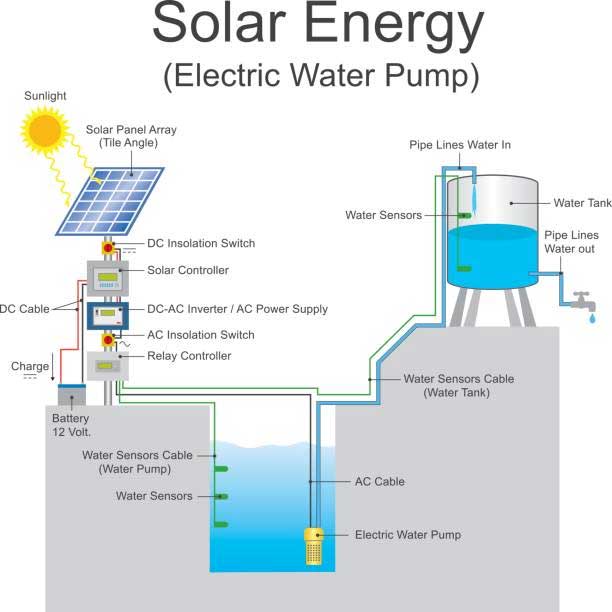SOLAR ROOFTOP PV POWER PROJECTS
A solar pump is a result of photovoltaic technology converting solar energy into electricity helping the motor and pump to run. The power generates ample amounts of energy to draw water from the borewell, river, lake or pond to the lands.
PROCESS
To understand more scientifically, the execution of the whole process starts with the photovoltaic cells in solar modules that convert sunlight into Direct Current (DC) electrical energy. This DC energy is then fed to the Motor Pump Set via Pump Controller in case of DC pump or via Variable Frequency Drive (VFD) in case of AC pumps (VFD controls the speed of Motor). The Pumping system is a combination of an impeller and a motor; the impeller propels water movement and the motor drives the pump. The water finally is propelled out of the borewell/river/lake/pond through the pipe so that water can then be fed to the fields for irrigation and other purposes.

Even though the water output varies during the day depending upon varying solar irradiance yet it does not cause major issues and gives various benefits in return; to count few of the perks, the solar pump sets us free from the high expenses of diesel and helps higher yield during the day time when crop gets all the necessary ingredients - sunlight and water!
WHY TO CHOOSE IT
It helps people to output water across all seasons to cultivate multiple crops every year all at the cost of the one-time investment and then zero running costs (free sunlight) for many years to come! It makes it easier for farmers to cultivate the land during day time rather than at night when the grid remains erratic. Even the drip and sprinkler systems can be connected with the solar system to further improve crop yield.
The hardest part of any system is the maintenance; the solar system needs no maintenance except regular cleaning of the modules. As there are no consumables, therefore it adds to the ease of operation. As the water can be harnessed any time of the day, the user can plan their other activities independently which might add to the relief. Not only is it a relief to the people but also the environment as it contributes to the reduction of carbon emission and pollution.
HOW TO OPERATE / MUST KNOW BEFORE USING
Before using, it is necessary for the user to check the connections and cables periodically for any damages and reports. Apart from that, one must always operate the controller with dry hands due to the obvious risk of electric shock, it is advised to let a trained person handle it.
- By setting the tracker to the suggested position, you can get the most accurate results.
- After sunset, when operating in manual mode, modules must be brought to a stow position which is parallel to the earth. Also, be careful and check safety ropes for damages and immediately replace them when needed.
- Keeping the controller box locked is a mandatory step that needs to be followed. Let the professionals take charge if the controller or actuator is not working.
- The only thing every user must be careful about is not to replace any modules with modules of other make or rating and not to open the connections between the modules. The junction box must not be operated by an untrained person as it might cause long term issues and losses.
- One must remain mindful of checking the systems after storms and heavy rains to ensure healthy working. During dusk or dawn when the modules are at regular temperatures, the user might clean them.
- After sunset, when operating in manual mode, modules must be brought to a stow position which is parallel to the earth. Also, be careful and check safety ropes for damages and immediately replace them when needed.
- Lastly, one must understand that not everything depends on your power system but also your borewell connection. Once everything is checked off the list, one is set to produce the best yields in the most sustainable and affordable way yet invented.
